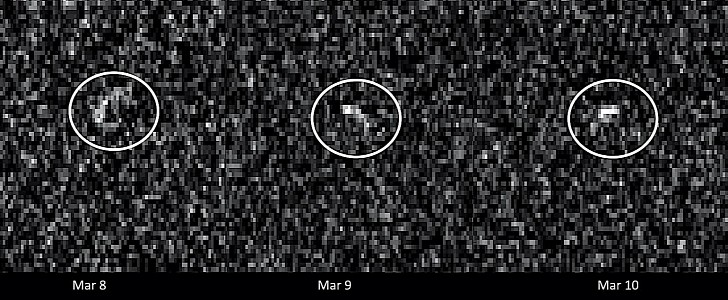It’s not a nice feeling knowing that at any time, a huge piece of space rock could slam onto our heads and end life as we know it. Luckily, unlike all the other species that have ever roamed our planet, humans can track some of these celestial hazards and, if need be, possibly even mount a defense against them.
Of the impossible-to-accurately-count asteroids and comets out there, one stands out as a real danger for Earth. It’s called 99942 Apophis, named after the Egyptian deity that was the enemy of the Sun god Ra, and was discovered in 2004 by a team from the Kitt Peak National Observatory (KPNO).
Apophis caused an adrenaline rush in people close to the matter several times, with math showing it had a probability of up to 2.7 percent (FYI, that’s huge when it comes to the vastness of space) of hitting Earth in 2029 and then doing something similar in 2036, and 2068.
As with any things space-related, math on this subject never ends, and the most recent results show that we should be safe from Apophis for at least the next 100 years or so. The people looking at the asteroid used radar observation of the thing as it passed closer to our planet earlier in March to determine this.
“A 2068 impact is not in the realm of possibility anymore, and our calculations don’t show any impact risk for at least the next 100 years,” said in a statement Davide Farnocchia of NASA’s Center for Near-Earth Object Studies (CNEOS).
“With the support of recent optical observations and additional radar observations, the uncertainty in Apophis’ orbit has collapsed from hundreds of kilometers to just a handful of kilometers when projected to 2029. This greatly improved knowledge of its position in 2029 provides more certainty of its future motion, so we can now remove Apophis from the risk list.”
The main tool used to determine this was the radio antenna at the Deep Space Communications Complex near Barstow, California. The Green Bank Telescope in West Virginia was also on deck to help.
Determinations were made, though, that in 2029 the 1,100 feet (340 meters) rock will pass by Earth at a distance that is closer than the present-day geosynchronous satellites. It should whoosh by at 20,000 miles (32,000 km) from our planet’s surface, and it will be visible from the Eastern Hemisphere with only the power of the human eyes.
Back in 2019, initial plans were drafted by scientists to design a spacecraft that could possibly go out and greet the asteroid and study it from up-close. There’s no word on what happened to that idea, except for South Korea's intention to get involved.
Apophis caused an adrenaline rush in people close to the matter several times, with math showing it had a probability of up to 2.7 percent (FYI, that’s huge when it comes to the vastness of space) of hitting Earth in 2029 and then doing something similar in 2036, and 2068.
As with any things space-related, math on this subject never ends, and the most recent results show that we should be safe from Apophis for at least the next 100 years or so. The people looking at the asteroid used radar observation of the thing as it passed closer to our planet earlier in March to determine this.
“A 2068 impact is not in the realm of possibility anymore, and our calculations don’t show any impact risk for at least the next 100 years,” said in a statement Davide Farnocchia of NASA’s Center for Near-Earth Object Studies (CNEOS).
“With the support of recent optical observations and additional radar observations, the uncertainty in Apophis’ orbit has collapsed from hundreds of kilometers to just a handful of kilometers when projected to 2029. This greatly improved knowledge of its position in 2029 provides more certainty of its future motion, so we can now remove Apophis from the risk list.”
The main tool used to determine this was the radio antenna at the Deep Space Communications Complex near Barstow, California. The Green Bank Telescope in West Virginia was also on deck to help.
Determinations were made, though, that in 2029 the 1,100 feet (340 meters) rock will pass by Earth at a distance that is closer than the present-day geosynchronous satellites. It should whoosh by at 20,000 miles (32,000 km) from our planet’s surface, and it will be visible from the Eastern Hemisphere with only the power of the human eyes.
Back in 2019, initial plans were drafted by scientists to design a spacecraft that could possibly go out and greet the asteroid and study it from up-close. There’s no word on what happened to that idea, except for South Korea's intention to get involved.


